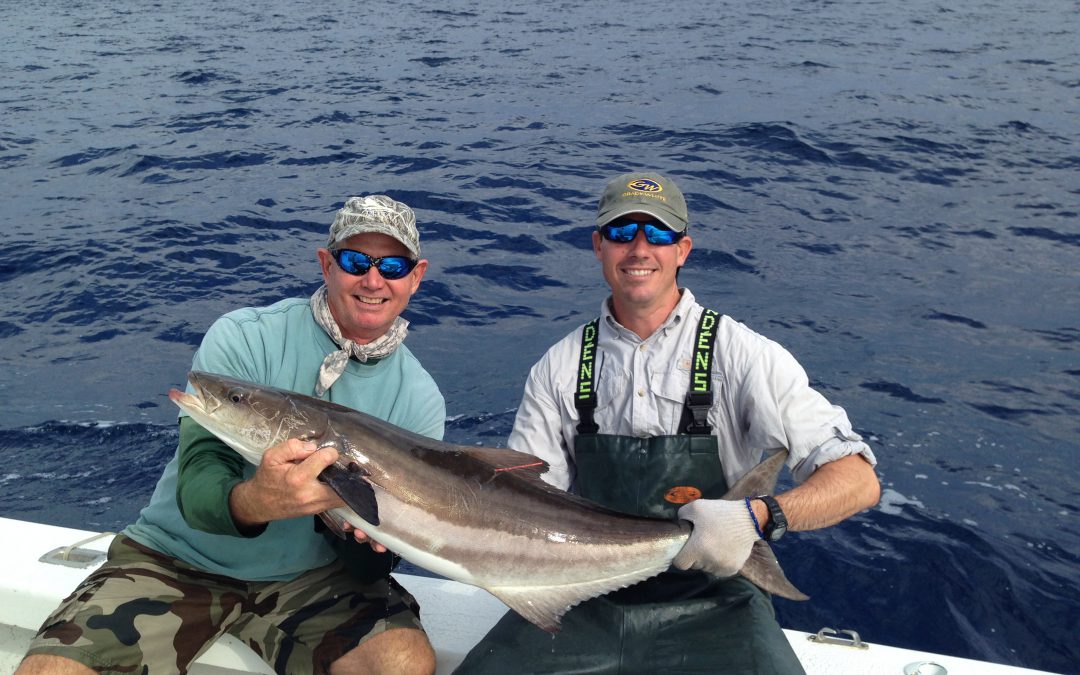
by Erik Lovestrand | Mar 11, 2021
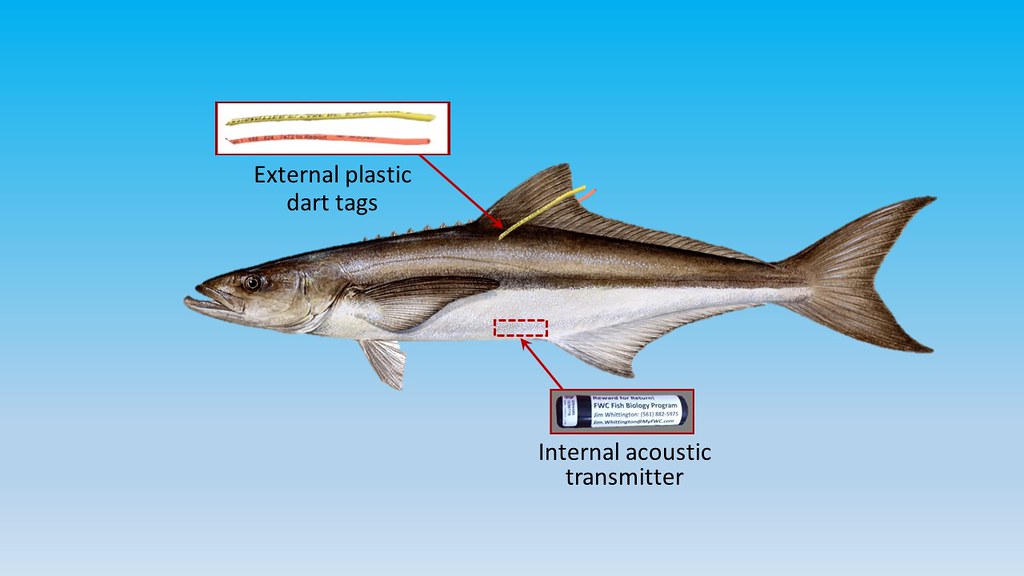
Cobia Researchers use Transmitters as well as Tags to Gather Data on Migratory Patterns
I must admit to having very limited personal experience with Cobia, having caught one sub-legal fish to-date. However, that does not diminish my fascination with the fish, particularly since I ran across a 2019 report from the Gulf States Marine Fisheries Commission titled “Management Profile for Gulf of Mexico Cobia.” This 182-page report is definitely not a quick read and I have thus far only scratched the surface by digging into a few chapters that caught my interest. Nevertheless, it is so full of detailed life history, biology and everything else “Cobia” that it is definitely worth a look. This posting will highlight some of the fascinating aspects of Cobia and why the species is so highly prized by so many people.
Cobia (Rachycentron canadum) are the sole species in the fish family Rachycentridae. They occur worldwide in most tropical and subtropical oceans but in Florida waters, we actually have two different groups. The Atlantic stock ranges along the Eastern U.S. from Florida to New York and the Gulf stock ranges From Florida to Texas. The Florida Keys appear to be a mixing zone of sorts where Cobia from both stocks go in the winter. As waters warm in the spring, these fish head northward up the Atlantic and Gulf coasts of Florida. The Northern Gulf coast is especially important as a spawning ground for the Gulf stock. There may even be some sub-populations within the Gulf stock, as tagged fish from the Texas coast were rarely caught going eastward. There also appears to be a group that overwinters in the offshore waters of the Northern Gulf, not making the annual trip to the Keys. My brief summary here regarding seasonal movement is most assuredly an over-simplification and scientists agree more recapture data is needed to understand various Cobia stock movements and boundaries.
Worldwide, the practice of Cobia aquaculture has exploded since the early 2000’s, with China taking the lead on production. Most operations complete their grow-out to market size in ponds or pens in nearshore waters. Due to their incredible growth rate, Cobia are an exceptional candidate for aquaculture. In the wild, fish can reach weights of 17 pounds and lengths of 23 inches in their first year. Aquaculture-raised fish tend to be shorter but heavier, comparatively. The U.S. is currently exploring rules for offshore aquaculture practices and cobia is a prime candidate for establishing this industry domestically.
Spawning takes place in the Northern Gulf from April through September. Male Cobia will reach sexual maturity at an amazing 1-2 years and females within 2-3 years. At maturity, they are able to spawn every 4-6 days throughout the spawning season. This prolific nature supports an average annual commercial harvest in the Gulf and East Florida of around 160,000 pounds. This is dwarfed by the recreational fishery, with 500,000 to 1,000,000 pounds harvested annually from the same region.
One of the Cobia’s unique features is that they are strongly attracted to structure, even if it is mobile. They are known to shadow large rays, sharks, whales, tarpon, and even sea turtles. This habit also makes them vulnerable to being caught around human-made FADs (Fish Aggregating Devices). Most large Cobia tournaments have banned the use of FADs during their events to recapture a more sporting aspect of Cobia fishing.
To wrap this up I’ll briefly recount an exciting, non-fish-catching, Cobia experience. My son and I were in about 35 feet of water off the Wakulla County coastline fishing near an old wreck. Nothing much was happening when I noticed a short fin breaking the water briefly, about 20 yards behind a bobber we had cast out with a dead pinfish under it. I had not seen this before and was unaware of what was about to happen. When the fish ate that bait and came tight on the line the rod luckily hung up on something in the bottom of the boat. As the reel’s drag system screamed, a Cobia that I gauged to be 4-5 feet long jumped clear out of the water about 40 yards from us. Needless to say, by the time we gained control of the rod it was too late; a heartbreaking missed opportunity. Every time we have been fishing since then, I just can’t stop looking for that short, pointed fin slicing towards one of our baits.
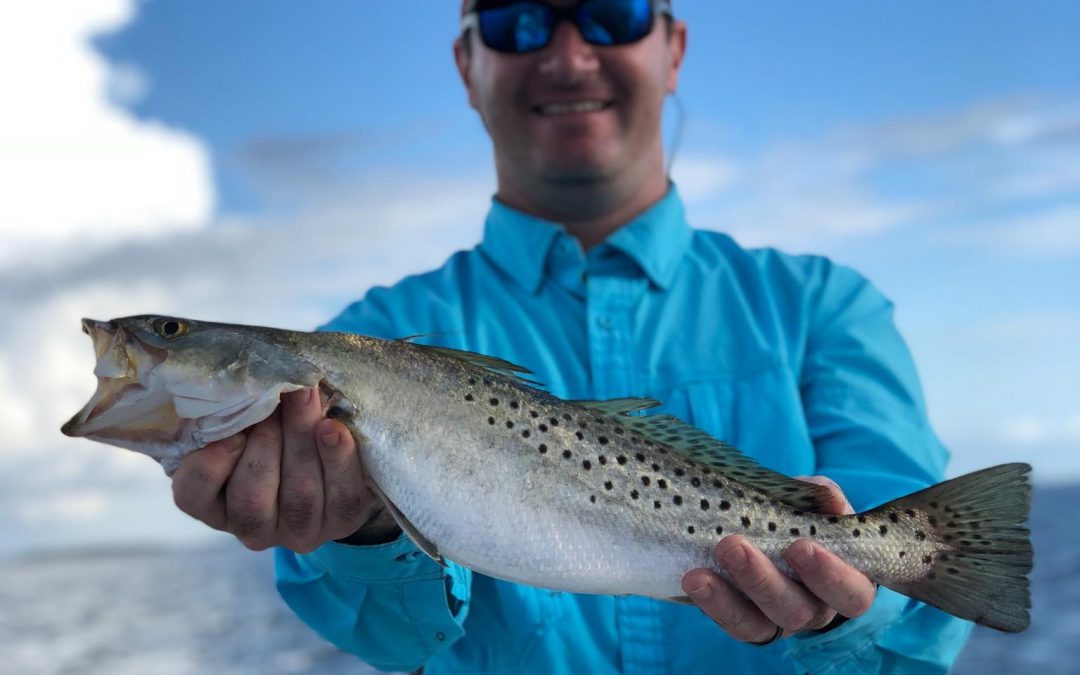
by Mark Mauldin | Feb 5, 2021
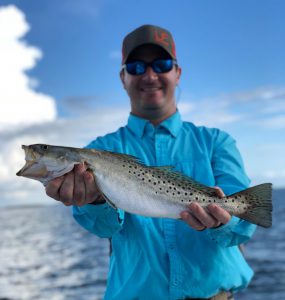
Reminder: Spotted seatrout harvest is closed in the Western Panhandle Management Zone the entire month of February.
New regulations were put into place last year reducing bag limits and closing harvest during February in the Western Panhandle Management Zone. For more details see my previous post on the subject.When Spotted Seatrout season is open (months other than February) in the Western Panhandle Management Zone the daily bag limit is 3 per harvester. Harvested Spotted Seatrout must be more than 15 inches long and less than 19 inches long. One fish, per vessel, over 19 inches my be included in the bag limit.
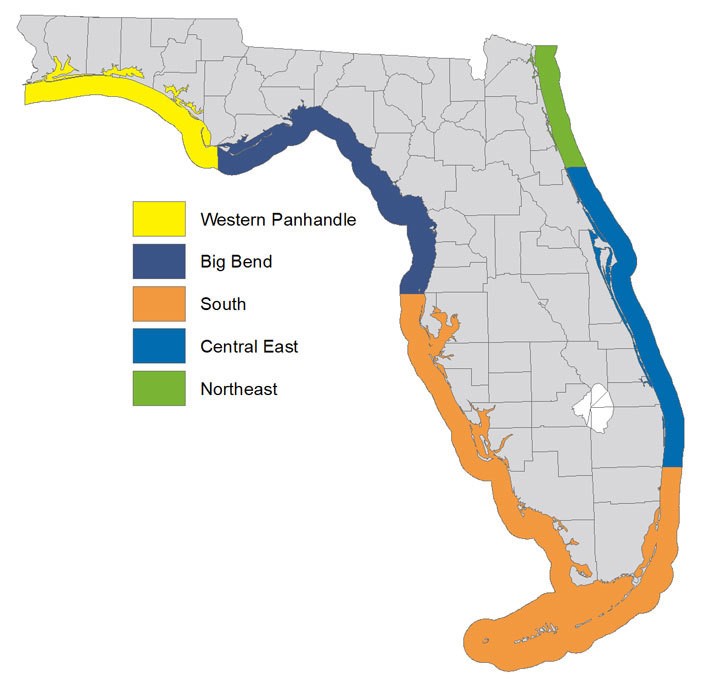
The Western Panhandle Spotted Seatrout Management Zone includes the State and federal waters of Escambia County through the portions of Gulf County west of longitude 85 degrees, 13.76 minutes but NOT including Indian Pass/Indian Lagoon.
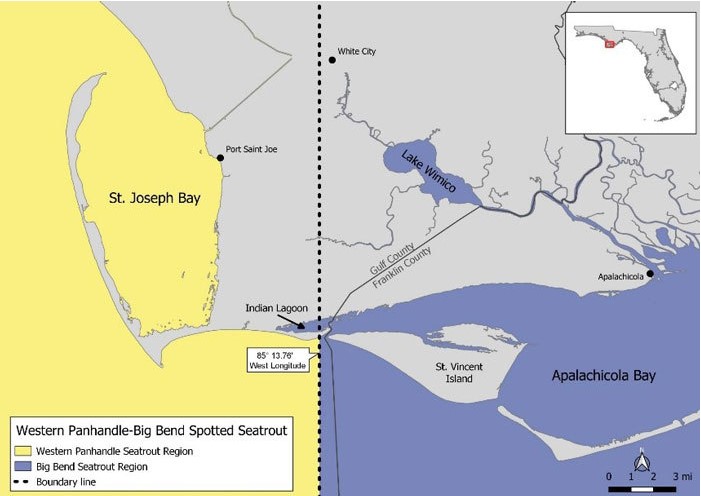
Boundary between the Western Panhandle and Big Bend spotted seatrout management zones.
Image source: www.myfwc.com
See myfwc.com for complete information on all game and fish regulations in Florida.
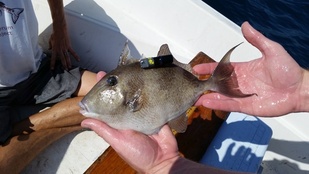
by Rick O'Connor | Oct 16, 2020
When most people think of reefs, they think of the coral reefs of the Florida Keys and Australia. But here in the northern Gulf the winters are too cold for many species of corals to survive. Some can, but most cannot and so we do not have the same type of reefs here.
That said, we do have reefs. We have both natural and artificial reefs. There are natural reefs off Destin and a large reef system off the coast of Texas – known as the “Flower Gardens”. Here the water temperatures on the bottom are warm enough to support some corals. The artificial reef program along the northern Gulf is one of the more extensive ones found anywhere. There is a science to designing an artificial reef – you do not just go out and dump whatever – because if not designed correctly, you will not get the fish assemblages and abundance you were hoping for. But if you do… they will come.
Reefs are known for their high diversity and abundance of all sorts of marine life – including fishes. There are numerous places to hide and plenty of food. Most of the fish living on the reef are shaped so they can easily slide in and out of the structure, have teeth that can crush shell – the parrotfish can actually crush and consume the coral itself, and some can be fiercely territorial. There are numerous tropical species that can be found on them and they support a large recreational diving industry. Let’s look at a few of these reef fish.
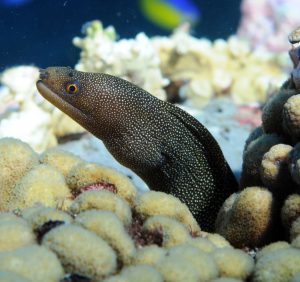
Moray eel.
Photo: NOAA
Moray Eels
These are fish of legend. There all sorts of stories of large morays, with needle shaped teeth, attacking divers. Some can get quite large – the green moray can reach 8-9 feet and weigh over 50 pounds. Though this species is more common in the tropics, it has been reported from some offshore reefs in the northern Gulf. There are three species that reside in our area: the purplemouth, the spotted, and the ocellated morays. The local ones are in the 2-3 foot range and have a feisty attitude – handle with care – better yet… don’t handle. They hide in crevices within the reef and explode on passing prey, snagging them with their sharp teeth. Many divers encounter them while searching these same crevices for spiny lobster. There are probing sticks you can use so that you do not have to stick your hand in there. There are rumors that since they have sharp teeth and tend to bite, they are venomous – this is not the case, but the bite can be painful.

The massive size of a goliath grouper. Photo: Bryan Fluech Florida Sea Grant
Groupers
This word is usually followed by the word “sandwich”. One of the more popular food fish, groupers are sought by anglers and spearfishermen alike. They are members of the serranid family (“sea basses”). This is one of the largest families of fishes in the Gulf – with 34 species listed. 15 of these are called “grouper” and there have been other members of this family sold as “grouper”.
So, what is – or is not – a “grouper”. One method used is anything in the genus Epinephelus would be a grouper. This would include 11 species, but would leave out the Comb, Gag, Scamp, Yellowfin, and Black groupers – which everyone considers “grouper”. Tough call eh?
These are large bodied fish with broad round fins – the stuff of slowness. That said, they can explode, just like morays, on their prey. Anglers who get a grouper hit know it, and divers who spear one know it. They range in size from six inches to six feet. The big boy of the group is the Goliath Grouper (six feet and 700 pounds). They love structure – so natural and artificial reefs make good homes for them. They also like the oil rigs of the western Gulf.
An interesting thing about many serranids is the fact they are hermaphroditic – male and female at the same time. Most grouper take it a step further – they begin life as females and become males over time.
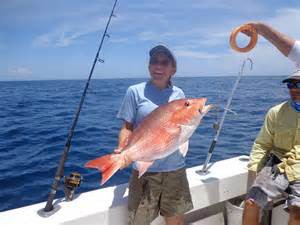
The king of finfish… the red snapper
Photo: Florida Sea Grant
Snappers
The red snapper is king. Prized as a food fish all over the United States, and beyond, these fish have made commercial fishermen very happy. With an average length of 2.5 feet, some much larger individuals have been landed. This fishery put Pensacola on the map in the early 20th century. Sailing vessels called “Snapper Smacks” would head out to the offshore banks and natural reefs, return with a load, and sell both locally and markets in New York. There are large populations in Texas waters and down on the Campeche Banks off Mexico. “Snapper Season” is a big deal around here.
Though these are reef fish, snapper have a habit of feeding above, and away from, them. You probably knew there was more than one kind of snapper but may not know there are 10 species locally. Due to harvesting pressure, there are short seasons on the famous red snapper – so vermillion snapper has stepped in as a popular commercial fishery – and it is very good also. Some, like the gray snapper, are more common inshore around jetties and seawalls. Also known as the black snapper or mangrove snapper, this fish can reach about three feet in length and make a good meal as well.
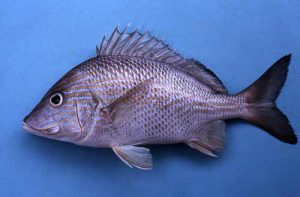
The white grunt.
Photo: University of Florida
Grunts
Grunts look just like snapper, and probably sold as them somewhere. But they are a different family. They lack the canines and vomerine teeth the snappers have – other than that, they do look like snapper. Easy to tell apart right? Vomerine are tiny teeth found in the roof of the mouth, in snappers they are in the shape of an arrow. They get their name from a grunting sound they make when grinding their pharyngeal teeth together. A common inshore one is called the “pigfish” because of this. They do not get as large as snapper (most are about a foot long) and are not as popular as a food fish, but the 11 known species are quite common on the reefs, and the porkfish is one of the more beautiful fish you will see there.
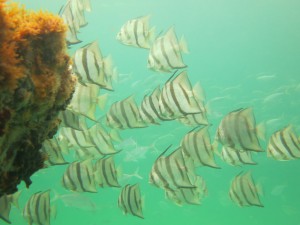
Spadefish on a panhandle snorkel reef.
Photo: Navarre Beach Snorkel
Spadefish
This is one of the more common fish found around our reefs. Resembling an angelfish, they are often confused with them – but they are in a family all to themselves. What is the difference you ask? The dorsal fin of the spade fish is divided into two parts – one spiny, the other more fin-like. In the angelfish, there is only one continuous dorsal fin.
Spadefish like to school and are actually good to eat. It is also the logo/mascot of the nearby Dauphin Island Sea Lab.
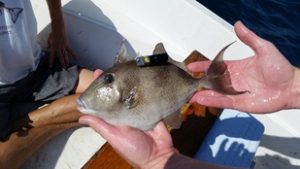
Gray triggerfish.
Photo: NOAA
Triggerfish
“Danger Will Robinson!” This fish has a serious set of teeth and will come off the reef and bite through a quarter inch wetsuit to defend their eggs. Believe it – they are not messing around. Once considered a by-catch to snapper fishermen, they are now a prized food fish. They are often called “leatherjackets” due to their fused scales forming a leathery like skin that must be cut off – no scaling with this fish. They have the typical tall-flat body of a reef fish, squeezing through the rocks and structure to hide or hunt. We have five species listed in the Gulf of Mexico, but it is the Gray Triggerfish that is most often encountered.
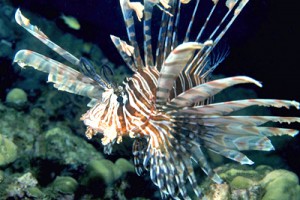
Photo courtesy of Florida Sea Grant
Lionfish
You may, may not, have heard of this one – most have by now. It is an invader to our reefs. To be an invasive species you must #1 be non-native. The lionfish is. There are actually about 20 species of lionfish inhabiting either the Indo-Pacific or the Red Sea region.
#2 have been brought here by humans (either intentionally or unintentionally – but they did not make it on their own) – this is the case with the lionfish. It was brought here for the aquarium trade. There are actually two species brought here: The Red Lionfish (Pterois volitans) and the Devilfish (Pterois miles). Over 95% of what has been captured are the red lionfish – but it really does not matter, they look and act the same – so they are just called “lionfish”.
#3 they must be causing an environmental, and/or an economic problem. Lionfish are. They have a high reproductive rate – an average of 30,000 offspring every four days. There is science that during sometimes of the year it could be higher, also they breed year-round. Being an invasive species, there are few predators and so the developing young (encapsulated in a gelatinous sac) drift with the currents to settle on new reefs where they will eat just about anything they can get into their mouths. There have been no fewer than 70 species of small reef fish they have consumed – including the commercially valuable vermillion snapper and spiny lobster. There is now evidence they are eating other lionfish.
They quickly take over a reef area and some of the highest densities in the south Atlantic region have been reported off Pensacola. However, at a 2018 state summit, researchers indicated that the densities in our area have declined in waters less than 200 feet. This is most probably due to the harvesting efforts we have put on them. They are edible – actually, quite good, and there is a fishery for them. Derbies and ecotours have been out spearfishing for them since 2010. You may have heard they were poisonous and dangerous to eat. Actually, they are venomous, and the flesh is fine. The venom is found in the spines of the dorsal, pelvic, and anal fins. It is very painful, but there are no records of anyone dying from it. Work and research on management methods continue.
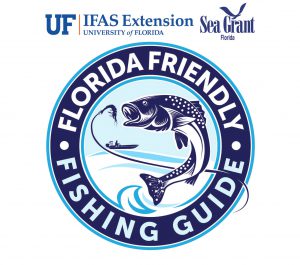
by Laura Tiu | Jul 3, 2020
Fishing is big business in Florida, contributing billions of dollars each year to the state’s economy. Fishing guides are an important part of the fishing industry. Guides provide locals and tourists alike with authentic Florida fishing experiences and memories that last a lifetime. Fishing guides are role models that can teach ethical angling through their onboard behaviors.
The Florida Friendly Fishing Guides Certification was developed by the University of Florida IFAS Extension, Florida Sea Grant, and the Florida Fish and Wildlife Conservation Commission with input from fishing guides. It is a voluntary certification program and involves no regulatory component. The target audience is flats guides, charter boat captains, and head-boat captains and crew. Recreational fishers are welcome to take the course, too.
What will I learn?
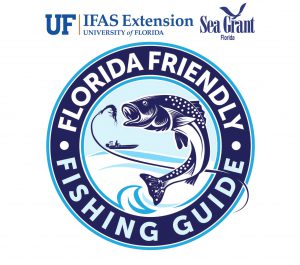 The Florida Sea Grant Florida Friendly Fishing Guide online course teaches best practices for catch and release fishing. Each lesson plan focuses on a different aspect of ethical angling. There are modules on seafood safety, federal and state fisheries management, onboard waste management, and how to teach your customers about the environment.
The Florida Sea Grant Florida Friendly Fishing Guide online course teaches best practices for catch and release fishing. Each lesson plan focuses on a different aspect of ethical angling. There are modules on seafood safety, federal and state fisheries management, onboard waste management, and how to teach your customers about the environment.
One environmental impact of fishing is what we call discard mortality. This is when a caught fish is released but does not survive. You will learn how to increase fish survival, how to identify barotrauma, and how to use descending and venting tools.
Starting July 15, 2020, a descending device will be required for head-boats, charter boats, commercial, and recreational vessels fishing for reef fish in federal waters of the Atlantic Ocean from North Carolina to Florida. The Florida Friendly Fishing Guide course will teach you how to identify barotrauma and select the right tool for sending fish back down to depth! Proper fish handling skills are important because up to 60% of caught fish are released.
The cost is $130 and the course takes about 4 hours to complete. Once you complete the course you receive a welcome package, public listing on the Florida Sea Grant website, and an optional social media promotion. For more information and registration go to https://www.flseagrant.org/florida-friendly-fishing-guide-certification/ or contact your local Florida Sea Grant agent, Laura Tiu, lgtiu@ufl.edu. Florida Friendly Fishing Guide Certification is a state-wide program for all saltwater fishing guides in Florida.
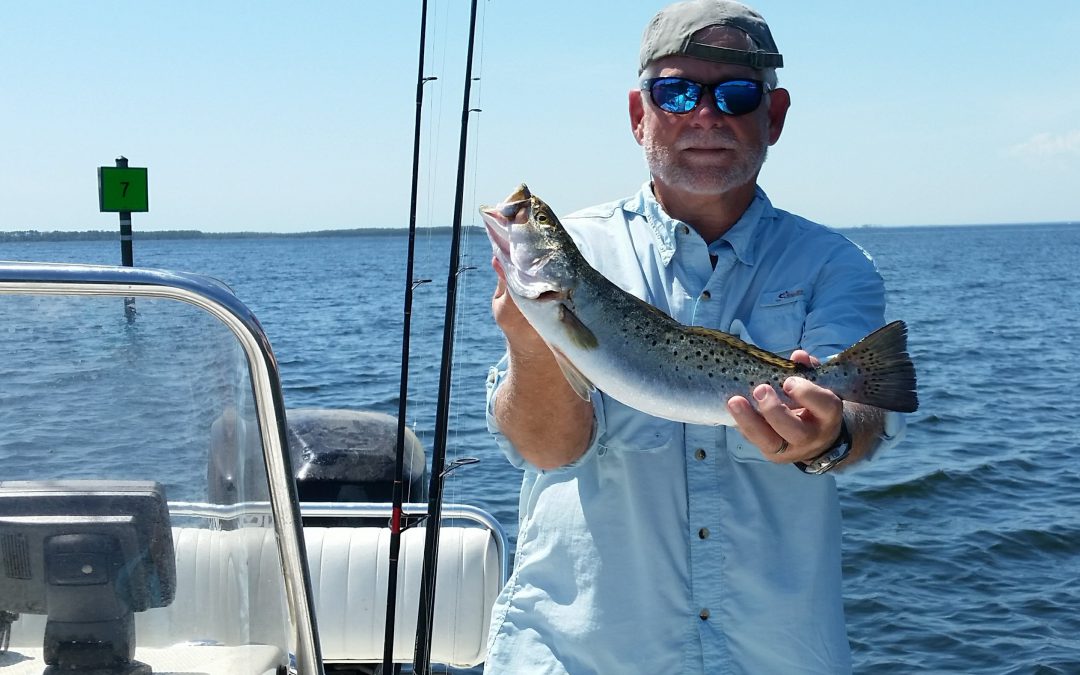
by Mark Mauldin | Feb 28, 2020
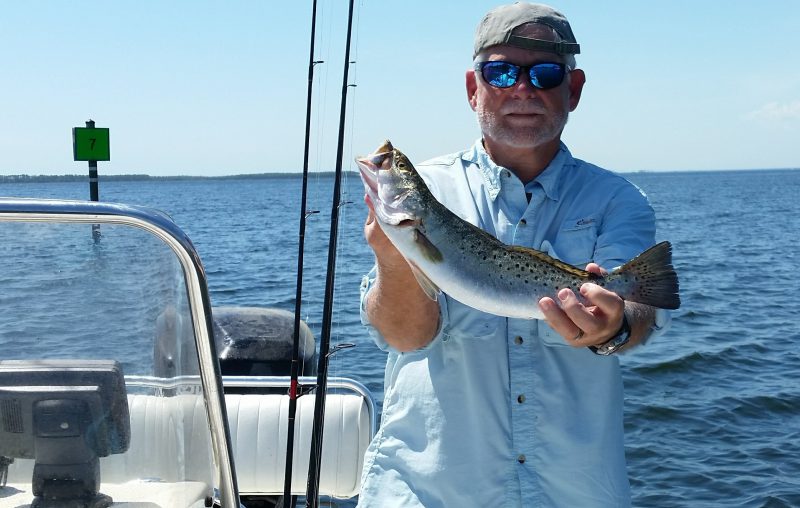
A spotted seatrout caught last summer in the St. Andrew’s Bay system (an area now included in the new Western Panhandle Management Zone).
Photo credit: Mark Mauldin
Recently FWC (Florida Fish & Wildlife Conservation Commission) announced rule changes relating to spotted seatrout.
The text was taken directly from FWC press releases; details not pertinent to NW Florida were removed.
Several rule changes for spotted seatrout [went] into effect Feb. 1, including a closure to spotted seatrout harvest in the new Western Panhandle management zone. Spotted seatrout are one of Florida’s most popular inshore fisheries. The Florida Fish and Wildlife Conservation Commission (FWC) made these changes after reviewing the results of a recent stock assessment and gathering input from anglers. These changes were made to benefit spotted seatrout populations while continuing to provide quality fishing opportunities.
The following rules [went] into effect Feb. 1, 2020:
- Creating two new zones by splitting the Northwest spotted seatrout management zone into the: (See maps below.)
- Western Panhandle (Escambia County through the portions of Gulf County west of longitude 85 degrees, 13.76 minutes but NOT including Indian Pass/Indian Lagoon).
- Big Bend (remaining portion of Gulf County plus Indian Lagoon, and Franklin County through Fred Howard Park Causeway in Pinellas County).
- Reducing bag limits
- Western Panhandle: three fish (was five).
- Big Bend: five fish (no change).
- Modifying the recreational slot size limit from 15-to-20 inches to 15-to-19 inches total length.
- Allowing one seatrout over 19 inches per vessel (currently per harvester).
- Prohibiting captain and crew from keeping a bag limit on a for-hire trip.
- Re-establishing the February recreational closure in the Western Panhandle zone.
Learn more about spotted seatrout by visiting MyFWC.com/Marine and clicking on “Recreational Regulations” and “Spotted Seatrout.”

Newly-approved FWC Spotted seatraout management zones, effective February 1, 2020
Image source: www.myfwc.com

New boundary between the Western Panhandle and Big Bend spotted seatrout management zones effective Feb. 1, 2020.
Image source: www.myfwc.com
Earlier this week Governor DeSantis announced the dates for the 2020 Gulf Red Snapper Season – June 11 through July 25.
Governor Ron DeSantis Announces 2020 Gulf Red Snapper Season
Tallahassee, Fla. – Today, Governor Ron DeSantis announced the popular 2020 Gulf red snapper recreational season is set to open June 11 through July 25, with a possible fall reopening if quota is available. This season will apply to those fishing from private recreational vessels in Gulf state and federal waters, and to charter vessels that do not have a federal reef fish permit and are limited to fishing in state waters only.
Earlier this month, Florida was delegated authority to manage recreational red snapper harvest from private vessels in Gulf federal waters.
“I’m pleased to announce that our state’s good conservation practices are allowing us to have a 45-day Gulf red snapper season this year,” said Governor DeSantis. “Gulf red snapper season is always an exciting time for anglers and is just another reason why Florida remains the Fishing Capital of the World.”
“Gulf red snapper is a conservation and management success story for Florida anglers,” said Florida Fish and Wildlife Conservation Commission (FWC) chairman Robert Spottswood. “Just a few years ago, a 45-day season for red snapper in both state and federal waters was out of reach. Thank you to all the stakeholders and anglers who helped make this season possible by providing input and sharing information about their fishing trips.”
“FWC is proud to be able to work with our stakeholders to balance conservation with fishing opportunities for Gulf red snapper and we are excited to see what the future holds as FWC takes the unprecedented step of managing this resource in both state and federal waters of the Gulf,” said Spottswood.
For more on recreational snapper regulations, visit MyFWC.com/Marine and click on “Recreational Regulations” and “Snapper” under the “Reef Fish” tab.
Follow the link for more information on Snapper fishing in Florida – FWC Snappers
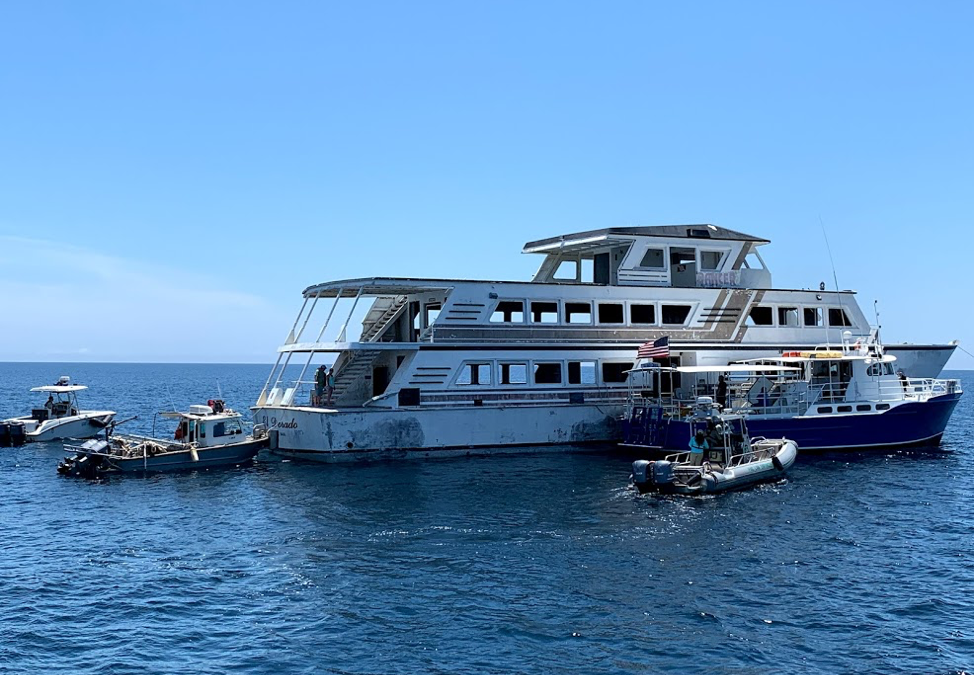
by Scott Jackson | Jun 21, 2019
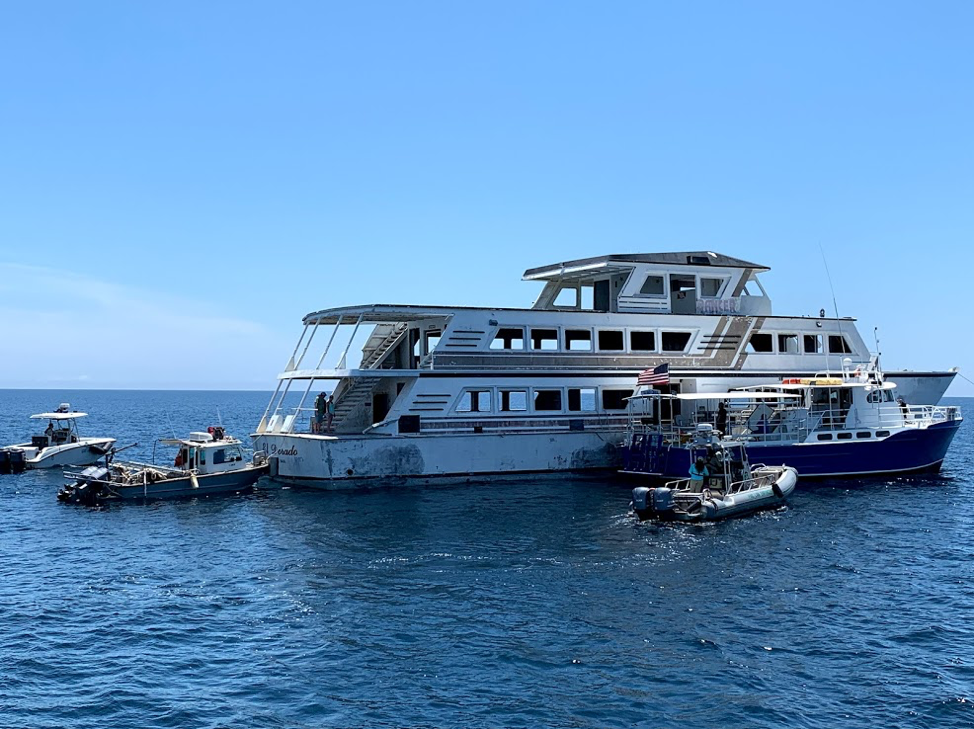
Panama City Dive Center’s Island Diver pulls alongside of the El Dorado supporting the vessel deployment by Hondo Enterprises. Florida Fish and Wildlife crews also are pictured and assisted with the project from recovery through deployment. The 144 foot El Dorado reef is located 12 nautical miles south of St Andrew Pass at 29° 58.568 N, 85° 50.487 W. Photo by L. Scott Jackson.
In the past month, Bay County worked with fishing and diving groups as well as numerous volunteers to deploy two artificial reef projects; the El Dorado and the first of the Natural Resources Damage Assessment (NRDA) reefs.
These sites are in Florida waters but additional opportunities for red snapper fishing are available this year to anglers that book for hire charters with captains holding federal licenses. Federal licensed Gulf of Mexico charters started Red Snapper season June 1st and continue through August 1st. Recreational Red Snapper fishing for other vessels in State and Federal waters is June 11th – July 12th. So booking a federally licensed charter can add a few extra fish to your catch this year.
The conversion of the El Dorado from a storm impacted vessel to prized artificial reef is compelling. Hurricane Michael left the vessel aground in shallow waters. This was in a highly visible location close to Carl Grey Park and the Hathaway Bridge. The Bay County Board of County Commissioners (BOCC) acquired the El Dorado, January 14, 2019 through negotiations with vessel owner and agencies responsible for recovery of storm impacted vessels post Hurricane Michael.
The El Dorado was righted and stabilized, then transported to Panama City’s St Andrews Marina by Global Diving with support from the Coast Guard and Florida Fish and Wildlife. Hondo Enterprises, was awarded a contract to complete the preparation and deployment of the vessel for use as an artificial reef.
Reefing the El Dorado provides new recreational opportunities for our residents and tourists. The new reef delivers support for Bay County’s fishing and diving charters continuing to recover after Hurricane Michael. Several local dive charter captains assisted in the towing and sinking of the El Dorado.
The El Dorado was deployed approximately 12 nm south of St. Andrew Bay near the DuPont Bridge Spans May 2, 2019. Ocean depth in this area is 102 feet, meaning the deployed vessel is accessible to divers at 60 feet below the surface.
The Bay County Board of County Commissioners continues to invest in the county’s artificial reef program just as before Hurricane Michael. Additional reef projects are planned for 2019 – 2020 utilizing Natural Resources Damage Assessment (NRDA) and Resources and Ecosystems Sustainability, Tourist Opportunities, and Revived Economies of the Gulf Coast States Act (RESTORE Act) funds. These additional projects total over 1.3 million dollars utilizing fines as a result of the Deepwater Horizon Oil Spill. Deployments will occur in state waters in sites located to both the east and west of St. Andrew Bay Pass.
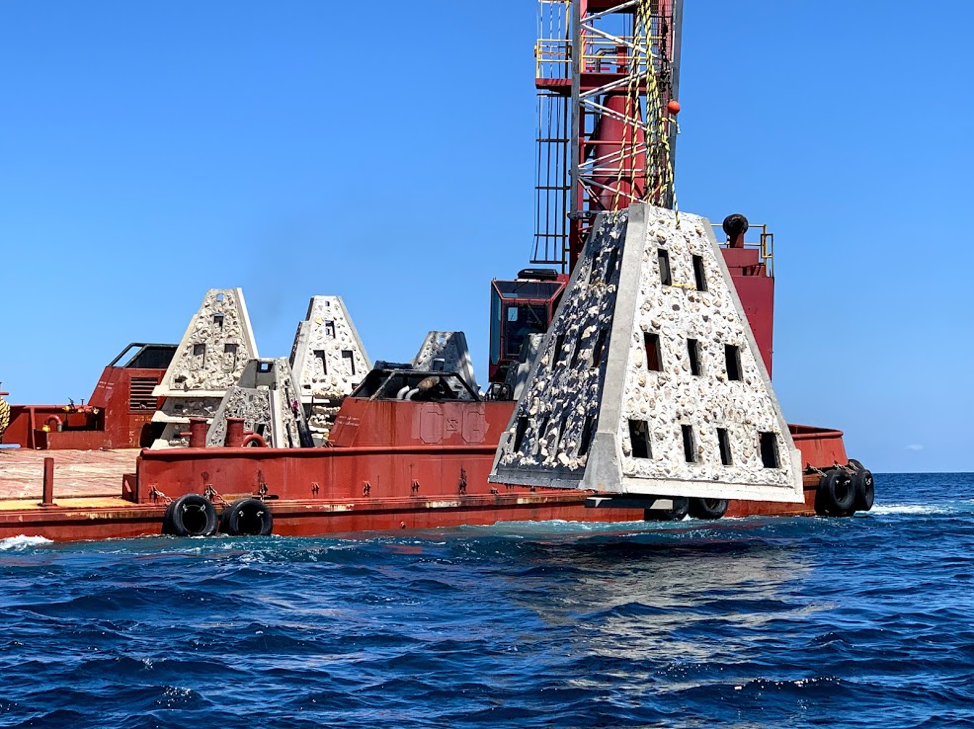
Walter Marine deploys one of nine super reefs deployed in Bay County’s NRDA Phase I project located approximately 12 nautical miles southeast of the St. Andrew Pass. Each massive super reef weighs over 36,000 lbs and is 15 ft tall. Multiple modules deployed in tandem provides equivalent tonnage and structure similar to a medium to large sized scuttled vessel. Photo by Bob Cox, Mexico Beach Artificial Reef Association.
The first of these NRDA deployments for Bay County BOCC was completed May 21, 2019 in partnership with Mexico Beach Artificial Reef Association, Florida Fish and Wildlife Conservation Commission, and Florida Department of Environmental Protection using a $120,000 portion of the total funding. The deployment site in the Sherman Artificial Reef Permit Area is approximately 12 nm south east of St Andrew Bay Pass at a depth of 78 – 80ft.
| Patch Reef # |
Latitude |
Longitude |
| BC2018 Set 1
(6 Super Reefs and 4 Florida Specials) |
29° 55.384 N |
85° 40.202 W |
| BC2018 Set 2
(1 Super Reef and 4 Florida Specials) |
29° 55.384 N |
85° 39.739 W |
| BC2018 Set 3
(1 Super Reef and 4 Florida Specials) |
29° 55.384 N |
85° 39.273 W |
| BC2018 Set 4
(1 Super Reef and 4 Florida Specials) |
29° 55.384 N |
85° 38,787 W |
In 2014, Dr. Bill Huth from the University of West Florida, estimated in Bay County the total artificial reef related fishing and diving economic impact was 1,936 jobs, $131.98 million in economic output and provided $49.02 million in income. Bay County ranked #8 statewide in artificial reef jobs from fishing and diving. Bay County ranked #3 in scuba diving economy and scuba diving was 48.4 % of the total jobs related to artificial reefs. Dr. Huth also determine that large vessels were the preferred type of artificial reef for fishing and diving, with bridge spans and material the next most popular. Scuba diving and fishing on artificial reefs contributes significantly to the county’s economic health.
For more information and assistance, contact UF/IFAS Extension Bay County at 850-784-6105 or Bay@ifas.ufl.edu. Follow us on Facebook at http://faceboook.com/bayifas .
An Equal Opportunity Institution. UF/IFAS Extension, University of Florida, Institute of Food and Agricultural Sciences, Nick T. Place, Dean for UF/IFAS Extension. Single copies of UF/IFAS Extension publications (excluding 4-H and youth publications) are available free to Florida residents from county UF/IFAS Extension offices.
This article is also available through the the Panama City New Herald





















